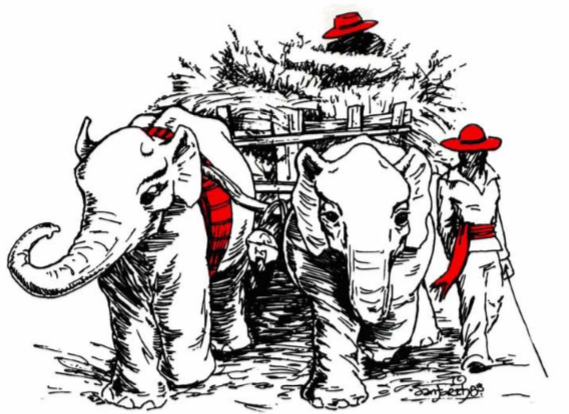Miniphant
| Miniphant | |
|---|---|
 | |
| Base Information | |
| Classification | Herbivore/grazer |
| Terrain | Forest |
| Locomotion | Walker |
| Size | 2.0m / 1,800kg |
| Speed | Unknown |
| Strength | Unknown |
| Social Structure | Unknown |
| Weapons | Unknown |
| Armor | Unknown |
| Source | |
| Homeworld | Terra (Solomani Rim 1827) |
| Multi-world | Yes |
| Canon | Yes |
| Extinct | Extant |
| Reference | Journal of the Travellers Aid Society No. 16 |
(Microelephas var.)
- A genus derived from the Terran Indian elephant (Elephas maximus indicus), genetically engineered for smaller size and greater intelligence.
Among the various species of miniphant are:
- The original species, Microelephas pristinus, and...
- The Wuan miniphant, Microelephas wuensis.
Physiology & Ecology
Miniphants were bred for tractability and high intelligence. They stand an average of 2.05 meters at the shoulder; males weigh 1800 kgs, females weigh 1600 kgs. No tusks are present, but miniphants compensate for this lack when lifting loads by having more powerful trunks. Miniphants have an extremely good sense of smell by nature, and superb hearing, making them difficult to surprise. The visual sense is not exceptional, and geneering was only partially successful in eliminating a tendency towards near-sightedness. The grey hide of a miniphant is as tough as cloth armor but is very sensitive to touch. The trunk is even more sensitive and susceptible to injury, but makes a fairly effective manipulative limb.
Miniphants, like many other elephant species, have some powerful abilities to aid their survival. Though they cannot tolerate cold weather, miniphants adapt well to higher temperatures to the limit of human tolerance. All swim exceptionally well. Their feet are padded in such a way as to permit them to move quite silently. Because of their foot structure, it is difficult for them to get stuck in the mud; the foot expands when it strikes the ground, and reduces its diameter when lifted.
Miniphants will rarely attack unless wounded or provoked. The usual tactics involve charging the victim and delivering a butt with the head, trampling with the feet, or seizing a tree branch or similar object in its trunk and flailing away.
Life Cycle & Reproduction
No information yet available.
Diet & Trophics
No information yet available.
History & Background (Dossier)
During the earliest days of expansion into space from Terra, a number of worlds were settled whose terrains challenged the best overland transportation systems. Dense jungle growth and swamplands foiled road building, and local vegetation sometimes proved nearly unkillable. Since the colonies had (initially at least) very low technologies, one solution to the problem was to use specially bred beasts of burden. These animals could be sent to the colonies in embryonic form, and soon became the low tech alternative to the truck and ATV on many worlds.
One of the animals developed for this program was geneered from the Terran Indian elephant. These beasts were ideal for overland travel in forests and lesser swamps. Later colonies carried the animals to other colonies, and over the years, numerous varieties were developed. The most popular of these are several species collectively referred to as miniphants, so called because of their smaller size and mass.
There is a fair chance of running across miniphants on worlds with tech levels between 0 and 3, and they can be found on some higher tech level worlds in remote and backward regions,employed as cargo handlers, pack and hauling beasts, and mounts. In addition, many worlds keep them in zoological collections, where they are popular exhibits. The cost of upkeep is about Cr150 per day, including 50 kg of hay and vegetable supplements and 50 liters of water.
Miniphants are quite intelligent for non-sapients. While they cannot speak, they can understand spoken commands readily, even when given in whispers. A large number of commands may be learned and will be retained for a long period of time, though few tasks of exceptional complexity will be known. Miniphants make slow but patient learners. They have emotions as humans do, play games and practical jokes, and are amiable.
If used as a pack animal or mount, miniphants can carry up to 350 kgs comfortably or can pull up to 2000 kgs in a wagon or cart.
Travellers' Aid Society Advisory
No information yet available.
References & Contributors (Sources)
| This article is missing content for one or more detailed sections. Additional details are required to complete the article. You can help the Traveller Wiki by expanding it. |
- Periodical: Classic Traveller Journal of the Travellers Aid Society No. 16
- GURPS Traveller: Sword Worlds (pg. 93)